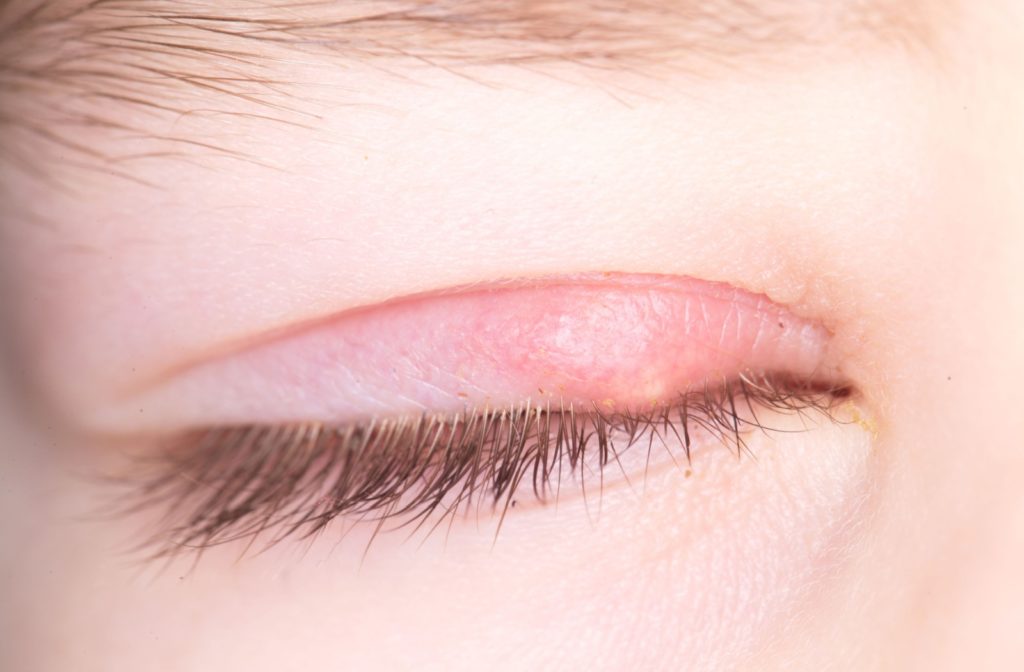Dealing with a stye—those uncomfortable red bumps on your eyelid—is rarely a fun experience. While a stye usually isn’t an emergency, this common eye condition is well-known for causing significant discomfort and some vision problems. And for many people who enjoy eyelash extensions, styes can often be a common occurrence. So, can eyelash extensions cause styes or is there more to it?
Eyelash extensions themselves don’t directly cause styes—but they do increase the chances of developing one. The glue used to apply eyelash extensions can block oil glands or hair follicles, leading to a bacteria buildup. Meanwhile, the lashes themselves may prevent you from properly cleaning the area, increasing your risk of styes.
What are Styes?
Styes, medically known as hordeolums, are red, painful lumps that form near the edge of your eyelid. Styes develop when a clogged hair follicle or oil gland starts to swell due to an infection, leading to a raised red bump in the affected area. These lumps often appear just like a pimple.
There are two types of styes:
- External: These form on the outer part of your eyelid and are more common.
- Internal: These occur inside the eyelid and are usually more painful than external ones.
Styes can be extremely uncomfortable and often develop due to poor hygiene practices or bacterial spread. They also can be recurring, but fortunately are temporary and tend to go away within a week or two.
What Causes Styes?
All across your skin, you have plenty of microscopic bacteria. These bacteria—primarily the staphylococcus bacteria—are usually harmless, and they’re a natural part of your body’s ecosystem.
However, they can occasionally move into the oil glands and hair follicles in and around your eyes. If these follicles become blocked in any way, it creates a perfect haven for these bacteria to multiply and thrive. This quickly leads to inflammation as your immune system tries to purge this infection.
These blockages can develop due to:
- Poor hygiene, like touching your eyes with dirty hands
- Poor oil flow from your oil glands
- Blepharitis (inflammation of the eyelids and infection)
- Stress
- Hormonal changes
- Using old makeup or sleeping with makeup in
In fact, styes can even develop due to eyelash extensions. The glue used to attach the eyelashes stays on your eyelids for weeks on end, and also makes it harder to clean the affected area. This quickly creates an ideal area for bacteria to thrive.
Your stylist could even be transmitting bacteria from their hands to your eyes, increasing the risk of styes. While the extensions themselves don’t cause styes, they do significantly increase the chances of developing one.
How to Tell If You Have a Stye
Fortunately, identifying a stye is relatively straightforward. Keep an eye out for visible redness and swelling near your eyelids; this is a sign of inflammation and potential infection. You also may notice:
- A small, red bump on the edge or inside of your eyelid
- Pain, discomfort, or tenderness in the affected area
- Mild discharge
- Watery eyes
- Light sensitivity
If you notice these symptoms, make sure that you avoid touching your eyes at all costs until the stye recedes. Don’t try to pop, squeeze, or scratch it; this spreads bacteria across your eyes and hands, making the odds of a severe eye infection much higher. Instead, talk to your optometrist if your stye is starting to affect your everyday life.

Can an Optometrist Remove a Stye?
Usually, styes go away on their own. This can take anywhere between a week or two. However, in some situations, the symptoms can be severe enough to warrant medical information. If your stye is too much of a problem, it’s time to see your optometrist. Remember—they’re an eye care professional and can help you find the right way forward.
Your optometrist will likely recommend antibacterial ointments or medication to help your body fight the bacteria infection. They also may advise you to try warm compresses; this can be a simple but effective way to find relief and open the clogged gland or follicle. Your optometrist may even recommend draining the stye in-office to help you find quick relief.
Tips for Preventing Styes
Preventing a stye is key to avoiding the discomfort these infections can cause. Proper hygiene is crucial, so make sure that you:
- Regularly wash your hands, especially before touching your eyes
- Clean your eyelids with a gentle cleanser
- Avoid sharing eye makeup with others, as this can easily transmit bacteria
- Replace any old makeup—especially if used around the eyes
- Never sleep with makeup on
These simple tips can make a difference and help prevent the onset of these infections.
Our Team Can Help
There’s no need to deal with a stye alone—not when help could be right around the corner. If you’re dealing with a stye—or anything unusual related to your eyes—come see our team at Total Vision Richmond.
Our team is here to help you find the relief you deserve, so book an appointment with us today!


